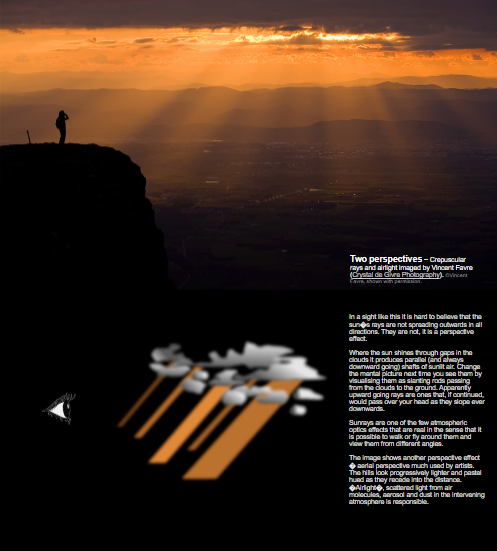Two perspectives
Two Perspectives: Exploring the Wonders of Atmospheric Optics
Have you ever gazed at the sky and marveled at the sun's rays streaming through gaps in the clouds? It's a captivating sight that often leaves us in awe. But have you ever wondered why these rays appear to spread outwards in all directions? In reality, it's all a matter of perspective.
Contrary to our initial perception, the sun's rays actually produce parallel shafts of sunlit air that always travel downwards. To visualize this phenomenon, imagine slanting rods extending from the clouds to the ground. Interestingly, if these rays were to continue their path, they would eventually slope downwards and pass over your head. It's a fascinating optical effect that challenges our intuition.
Unlike many other atmospheric optics effects, sunrays offer a unique opportunity to experience them from different angles. Whether you're walking or flying, you can explore the sun's rays up close and witness their beauty from various perspectives. It's a reminder of the dynamic nature of our atmosphere and the wonders it holds.
While sunrays provide a mesmerizing display, they are not the only perspective effect to captivate our senses. Another fascinating phenomenon known as aerial perspective, frequently utilized by artists, adds depth and beauty to our landscapes. As we gaze into the distance, we notice that hills appear progressively lighter and adorned with pastel hues. This ethereal transformation is caused by "airlight," which refers to scattered light from air molecules, aerosols, and dust present in the intervening atmosphere.
Aerial perspective is a testament to the interplay between light and the particles suspended in our atmosphere. As light travels through the air, it encounters these tiny particles, causing it to scatter in different directions. The scattered light interacts with our vision, giving distant objects a softer and lighter appearance. This effect is particularly noticeable when observing landscapes, where distant hills and mountains seem to blend harmoniously with the sky, creating a sense of depth and tranquility.
It's important to note that atmospheric optics is a vast field with numerous captivating phenomena waiting to be explored. From rainbows and halos to mirages and iridescence, our atmosphere is a treasure trove of visual wonders. Each of these phenomena offers its own unique perspective, providing us with a deeper understanding of the intricacies of light and its interaction with our environment.
As we delve into the world of atmospheric optics, we realize that our perception of the world is not always as straightforward as it seems. The interplay between light, particles, and our surroundings creates a tapestry of visual effects that continually amaze and inspire us. Whether it's the parallel shafts of sunlit air or the ethereal transformation of distant landscapes, these optical phenomena remind us of the beauty and complexity that surrounds us.
So, the next time you find yourself gazing at the sky or exploring nature's wonders, take a moment to appreciate the two perspectives at play. Embrace the awe-inspiring sunrays and the subtle nuances of aerial perspective. Allow yourself to be captivated by the intricate dance between light and our atmosphere, and let it deepen your appreciation for the marvels that exist just beyond our reach.

Two perspectives ~ Crepuscular rays and airlight imaged by Vincent Favre (Crystal de Givre Photography). ©Vincent Favre, shown with permission.
In a sight like this it is hard to believe that the sun�s rays are not spreading outwards in all directions. They are not, it is a perspective effect.
Where the sun shines through gaps in the clouds it produces parallel (and always downward going) shafts of sunlit air. Change the mental picture next time you see them by visualising them as slanting rods passing from the clouds to the ground. Apparently upward going rays are ones that, if continued, would pass over your head as they slope ever downwards.
Sunrays are one of the few atmospheric optics effects that are real in the sense that it is possible to walk or fly around them and view them from different angles.
The image shows another perspective effect � aerial perspective much used by artists. The hills look progressively lighter and pastel hued as they recede into the distance. �Airlight�, scattered light from air molecules, aerosol and dust in the intervening atmosphere is responsible.
Note: this article has been automatically converted from the old site and may not appear as intended. You can find the original article here.
Reference Atmospheric Optics
If you use any of the definitions, information, or data presented on Atmospheric Optics, please copy the link or reference below to properly credit us as the reference source. Thank you!
-
<a href="https://atoptics.co.uk/blog/two-perspectives/">Two perspectives</a>
-
"Two perspectives". Atmospheric Optics. Accessed on November 26, 2024. https://atoptics.co.uk/blog/two-perspectives/.
-
"Two perspectives". Atmospheric Optics, https://atoptics.co.uk/blog/two-perspectives/. Accessed 26 November, 2024
-
Two perspectives. Atmospheric Optics. Retrieved from https://atoptics.co.uk/blog/two-perspectives/.